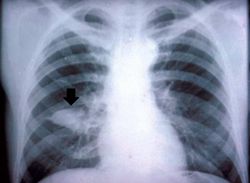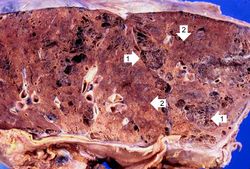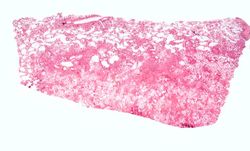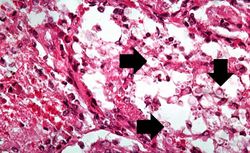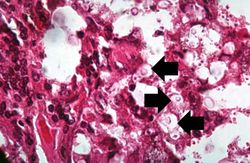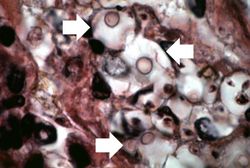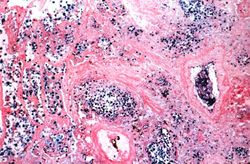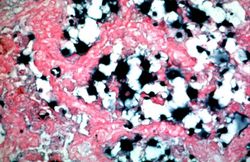Difference between revisions of "IPLab:Lab 10:Cryptococcosis"
Seung Park (talk | contribs) |
(→Clinical Summary) |
||
| (One intermediate revision by the same user not shown) | |||
| Line 1: | Line 1: | ||
== Clinical Summary == | == Clinical Summary == | ||
| − | This 46-year-old male presented with a complaint of right-sided chest pain of six months duration. Chest x-ray showed a nodular mass in the lower lobe of the right lung. The mass was resected surgically. | + | This 46-year-old male presented with a complaint of right-sided chest pain of six months duration. Chest x-ray showed a nodular mass in the lower lobe of the right lung. The mass was resected surgically. |
| − | + | The 3.5 x 2.5-cm mass was firm, gray, and gelatinous. The mass proved to be a cryptococcal lesion. | |
| − | |||
| − | The 3.5 x 2.5-cm mass was firm, gray, and gelatinous. The mass proved to be a cryptococcal lesion. | ||
== Images == | == Images == | ||
Latest revision as of 21:54, 9 July 2020
Contents
Clinical Summary[edit]
This 46-year-old male presented with a complaint of right-sided chest pain of six months duration. Chest x-ray showed a nodular mass in the lower lobe of the right lung. The mass was resected surgically.
The 3.5 x 2.5-cm mass was firm, gray, and gelatinous. The mass proved to be a cryptococcal lesion.
Images[edit]
Virtual Microscopy[edit]
H&E[edit]
Mucicarmine[edit]
Study Questions[edit]
Additional Resources[edit]
Reference[edit]
Journal Articles[edit]
- Rooney PJ, Klein BS. Linking fungal morphogenesis with virulence. Cell Microbiol 2002 Mar;4(3):127-37.
Images[edit]
Related IPLab Cases[edit]
| |||||
Nodular hyperplasia of the prostate--characterized by large discrete prostatic nodules--is a common disorder in men over 50 years of age. The nodules cause the prostate to be enlarged and to have an increased weight. The human prostate is surrounded by a restrictive capsule. These nodules cause increased pressure within the capsule which leads to constriction of the urethra as it passes through the prostate. Urethral constriction leads to retention of urine.
Pulmonary emphysema is a condition in which the air spaces distal to the terminal bronchioles are permanently increased in size due to either destruction of the wall or alveolar dilatation.
